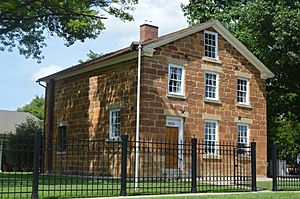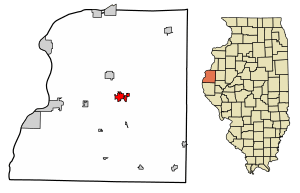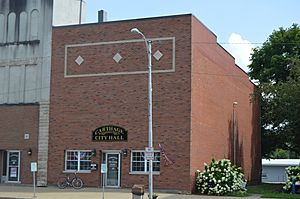Carthage, Illinois facts for kids
Quick facts for kids
Carthage, Illinois
|
|
|---|---|

The historic Carthage Jail, July 2015
|
|

Location of Carthage in Hancock County, Illinois.
|
|
| Country | |
| State | |
| County | Hancock |
| Township | Carthage |
| Founded | 1837 |
| Named for | Carthage |
| Area | |
| • Total | 2.50 sq mi (6.46 km2) |
| • Land | 2.50 sq mi (6.46 km2) |
| • Water | 0.00 sq mi (0.00 km2) |
| Elevation | 669 ft (204 m) |
| Population
(2020)
|
|
| • Total | 2,490 |
| • Density | 997.60/sq mi (385.16/km2) |
| Time zone | UTC-6 (CST) |
| • Summer (DST) | UTC-5 (CDT) |
| ZIP code |
62321
|
| Area code(s) | 217 |
| FIPS code | 17-11527 |
Carthage is a city and the county seat of Hancock County, Illinois, United States. The population was 2,490 as of the 2020 census, Carthage is best known for being the site of the 1844 death of Joseph Smith, founder of the Latter Day Saint movement.
History
The first European-Americans settlers arrived in Carthage and Hancock County in the first few decades of the 19th century. By 1833, they had erected simple buildings in Carthage, and the town was platted in 1838. By this time Carthage had been designated as the county seat of Hancock County.
While incarcerated in the Carthage Jail in June 1844, Joseph Smith, founder of the Latter Day Saint movement, and his brother Hyrum Smith were killed by a mob on Thursday, June 27, 1844.
On October 22, 1858, Abraham Lincoln spoke in Carthage while campaigning for the Senate. The speech spot is commemorated by a large stone on the south side of the Courthouse square.
Over the years the jail had been modified and used for different purposes. For a period the jail was home to Carthage College. The jail has been restored to a close approximation of its appearance in 1844 and is now owned by The Church of Jesus Christ of Latter-day Saints. The site, a full city block, is a historical visitor's center.
Regionally noted botanist, philanthropist, and traveler Dr. Alice L. Kibbe called Carthage home. Along with Dr. Kibbe's personal collections, Carthage's Kibbe Hancock Heritage Museum houses a variety of exhibits celebrating local and regional history.
Carthage is the only city in Illinois to have all of the jails ever used still in existence: The old jail, called the Mormon Jail; the jail next built which was also the Sheriff's residence and is on the south side of the Courthouse square; and the new jail, on Highway 136 on the city's west side.
The Hancock County Courthouse in Carthage, built in 1908, is the third courthouse for the county. It is at the center of the square in Carthage. The courthouse and shops surrounding the square have been listed on the National Register of Historic Places since 1986.
Geography
Carthage is located at 40°24′52″N 91°8′0″W / 40.41444°N 91.13333°W (40.414327, -91.133472).
According to the 2010 census, the city has a total area of 2.44 square miles (6.3 km2), all land.
In June, 2006 development property on the east side of Carthage was voluntarily annexed into the city limits. This property totaled approximately .43 square miles (1.1 km2), all land except for an eight-acre lake.
Demographics
| Historical population | |||
|---|---|---|---|
| Census | Pop. | %± | |
| 1870 | 1,448 | — | |
| 1880 | 1,594 | 10.1% | |
| 1890 | 1,654 | 3.8% | |
| 1900 | 2,104 | 27.2% | |
| 1910 | 2,373 | 12.8% | |
| 1920 | 2,129 | −10.3% | |
| 1930 | 2,240 | 5.2% | |
| 1940 | 2,575 | 15.0% | |
| 1950 | 3,214 | 24.8% | |
| 1960 | 3,325 | 3.5% | |
| 1970 | 3,350 | 0.8% | |
| 1980 | 2,978 | −11.1% | |
| 1990 | 2,657 | −10.8% | |
| 2000 | 2,725 | 2.6% | |
| 2010 | 2,605 | −4.4% | |
| 2020 | 2,490 | −4.4% | |
| U.S. Decennial Census | |||
2010 census
As of the 2010 Census, there were 2,605 persons living in 1,151 households in Carthage. With an area of 2.44 square miles, the population density was 1,067 persons per square mile. There were 1,308 total housing units, with an average density of 536 per square mile. Racially, 97.3% of Carthage residents identified themselves as white, 0.3% identified as Black/African American, 0.3% were Native American, and 0.4% identified themselves as Asian. No residents identified themselves as Pacific Islander. 0.5% of the remaining population identified themselves as belonging to some other race, while 1.2% belonged to multiple races. Between all races, 2.0% of the population identified as hispanic or Latino.
2007–2011 Census data showed 19.2% of Carthage residents were under the age of 18, while 22.6% of the population was over the age of 65. The median age in Carthage was 44.0 years, and there were 88.3 males for every 100 females. Of residents over the age of 15, 50.8% of persons were married. Of persons over the age of 25, 93.2% had earned at least a high school diploma while 19.2% had earned a bachelor's degree or higher. 7.2% of persons held a graduate degree.
For census data collected between 2007 and 2011, Carthage's median (middle) household income was $46,607, with a mean (average) household income of $51,584. The median per-capita income was $22,729. Unemployment was measured to be 7.9%, while 10.7% of persons and 8.8% of families lived with earnings below the federal poverty line.
Economy
Carthage's economy is centered around agriculture and supporting industries. The surrounding land is devoted to the cultivation of crops, especially corn and soybeans. Industrial hog farms are also near the city.
The company Methode Electronics, Inc. operates an auto parts production facility in Carthage, though the company no longer employs as large a portion of the population as was once the case.
Education
Beginning in August 2007, the Carthage High School (also known as Hancock County Central High School) building became the home of the newly formed Illini West High School, consolidating the high school districts of Carthage, La Harpe, and Dallas City. The three cities maintain separate facilities for elementary and middle schools.
Carl Sandburg College, a two-year community college in Galesburg, has a satellite campus on the north side of Carthage.
From 1870 to 1964, Carthage was home to Carthage College, which relocated to Kenosha, Wisconsin. From 1965 to 1975, Carthage was home to Robert Morris University–Illinois, which merged with Moser School of Business and relocated to Chicago.
The former Carthage College campus was purchased by Prairieland Investment Group in June 2007. (Hancock County Journal Pilot June 27, 2007) Some buildings are renovated for use by Carthage Veterinary Clinic. The auditorium was given to Carl Sandburg College, and has been restored for use by the college and for community presentations and events.
Notable people
- Orville F. Berry, Illinois state senator, lawyer, and businessman
- Virginia Cherrill, co-star of Charlie Chaplin in City Lights
- George Clark, college and pro football coach
- Mary Davidson, Illinois state representative and newspaper editor
- Beatrice Gray, actress
- John Nelson Hyde, Presbyterian Missionary in India (Punjab)
- John Mahoney, actor, is buried there
- Leroy A. Ufkes, Illinois state representative and lawyer
- Rip Williams, Major League Baseball player from 1911–18
See also
 In Spanish: Carthage (Illinois) para niños
In Spanish: Carthage (Illinois) para niños




